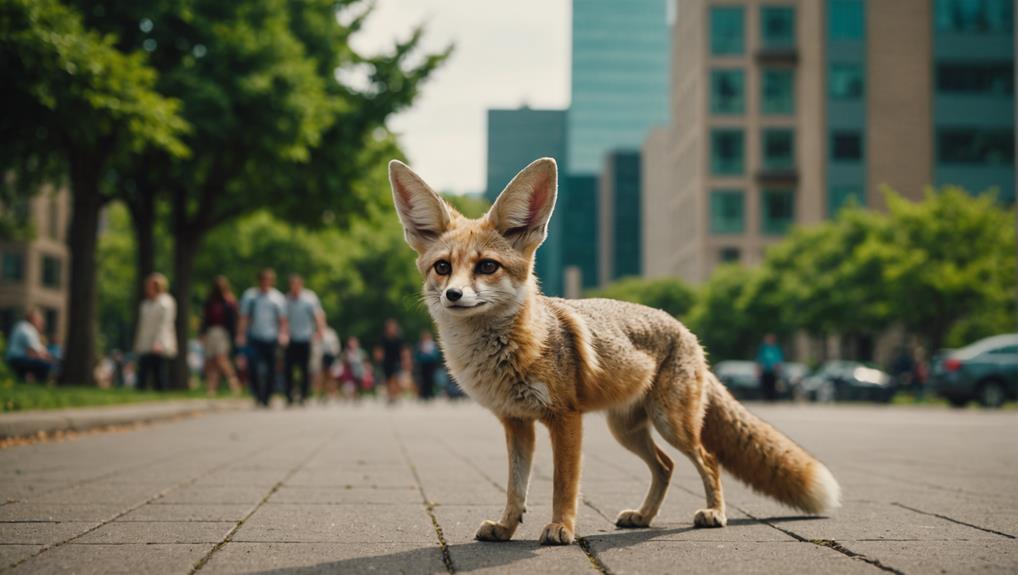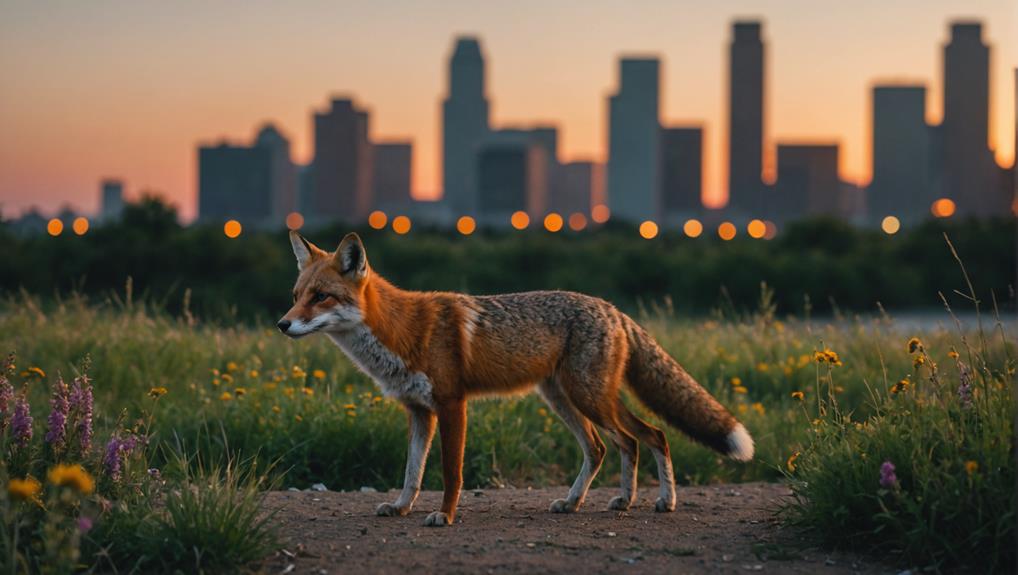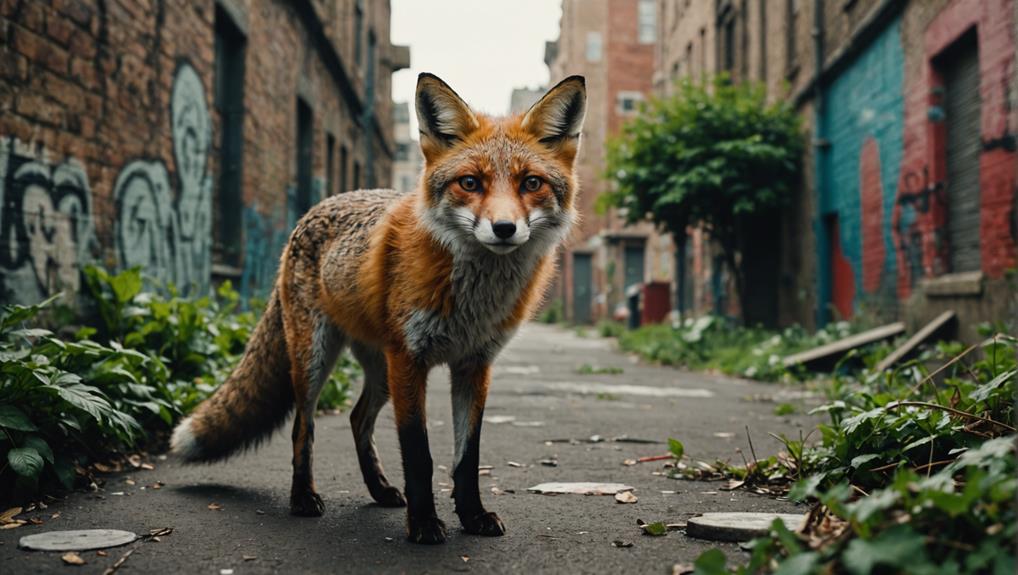You might be surprised to learn that urban environments are home to several clever fox species! The Red Fox loves to rummage through gardens for snacks like pizza crusts. Grey Foxes, with their tree-climbing skills, find cozy spots under decks. Fennec Foxes are adorable with their big ears, thriving in sandy areas. Then there are Arctic Foxes, who've swapped tundras for suburbs. Swift Foxes, Bengal Foxes, and Corsac Foxes also navigate city life, scavenging and adapting like pros. Each has a unique habitat and survival strategy, showing just how resourceful these furry friends can be. Curious about their antics? There's more to uncover!
Contents
Red Fox Adaptations in Cities
The red fox (Vulpes vulpes) has truly mastered the art of urban living, thriving in cities around the world. You might be surprised to learn that these clever creatures have adapted beautifully to urban areas.
With their ability to scavenge, urban foxes have become omnivorous champions, feasting on everything from small mammals to discarded pizza crusts. Talk about a gourmet meal!
In cities, red foxes find cozy den sites in gardens, parks, and even basements. They cleverly choose places that keep their cubs safe while blending into our human-dominated landscapes.
Nighttime is when the magic happens! By foraging under the cover of darkness, they avoid most human interactions, making their rounds like furry ninjas.
Did you know that the UK's urban fox population skyrocketed from 33,000 in 1995 to around 150,000 by 2017? That's a remarkable sign of adaptation!
These resilient animals have shown us how flexibility and resourcefulness can lead to success, even in bustling urban environments.
Grey Fox Urban Habitats
Grey foxes (Urocyon cinereoargenteus) are making their mark in urban landscapes across North America, showcasing impressive adaptability in residential areas, parks, and woodlands.
You might be surprised to know that these clever creatures thrive right alongside us, sneaking through backyards and exploring local green spaces. Their ability to climb trees sets them apart, providing them an escape route from potential threats.
In many urban habitats, grey foxes have taken advantage of habitat fragmentation caused by suburban development. This means they've found cozy den sites under decks, sheds, or other structures, keeping them safe from humans and vehicles.
Isn't it fascinating how they've made our neighborhoods their own?
Their diet is just as varied, as grey foxes feast on small mammals, birds, and even scavenged leftovers. This adaptability helps them thrive in city life, showing us that even wild animals can find a way to coexist with humans.
So next time you spot a grey fox darting through your neighborhood, remember they're not just passing through; they're making a home in the spaces we share!
Embrace the wildlife around you; it adds a touch of magic to your everyday life.
Fennec Fox in Urban Environments

Have you ever wondered how a fennec fox manages to thrive in urban settings?
Despite their desert roots, these little guys adapt surprisingly well to city life, especially in areas that mimic their natural sandy habitats.
With those big ears helping them hear at night, they're not just cute; they're clever little predators searching for snacks in the shadows!
Urban Adaptation Strategies
Fennec foxes showcase remarkable adaptability as they navigate urban environments, transforming abandoned buildings and gardens into their shelters. These clever little creatures thrive in the hustle and bustle of city life, proving that home doesn't always mean a quiet desert.
With their big ears, they manage to keep cool in the urban heat, making them perfectly suited for warmer climates where we humans often reside.
Their nocturnal behavior is a clever strategy, allowing them to avoid the busy daytime crowds while they forage for meals. You might spot them sneaking around parks or residential areas, taking advantage of the cooler nighttime temperatures. It's almost like they've figured out the best time to hit the town!
As these foxes adapt to their surroundings, their diets shift, too. Instead of just hunting small critters, they've become adept at scouring for food scraps left behind by humans.
Who knew that urban adaptation could lead to such resourcefulness? By embracing their unique skills, Fennec foxes remind us that even in the most unexpected places, nature finds a way to flourish.
Habitat Preferences and Challenges
In urban environments, Fennec foxes typically prefer areas that offer loose soil for burrowing and access to food sources, such as gardens and parks.
These clever little creatures have an incredible adaptability that allows them to make the most out of their urban surroundings. However, they face some challenges that can tug at your heartstrings.
Here are some of their struggles:
- Habitat Loss: As cities grow, space for these foxes shrinks.
- Human Encounters: More people means more chances for conflicts.
- Food Scarcity: Not every urban area provides reliable food sources.
- Nighttime Safety: Urban dangers can lurk even when the sun goes down.
Despite these challenges, Fennec foxes living in urban areas often utilize human-made structures like abandoned buildings for shelter, showcasing their resourcefulness.
Their large ears help them stay cool during those hot days, but at night, when they're out scavenging, they can still encounter obstacles.
Supporting these adorable foxes means recognizing their needs and advocating for their habitats.
Let's ensure they can continue to thrive in our cities, bringing a bit of wilderness to our urban lives!
Arctic Foxes in Suburban Areas
You might be surprised to spot an Arctic fox in your suburban neighborhood, but these clever little creatures can sometimes wander far from their chilly tundra homes.
When food gets scarce during harsh winters, they adapt their diet and behavior, seeking out birds or rodents in your backyard.
While watching one of these fluffy visitors can be exciting, it's important to remember that their presence often signals some environmental challenges at play!
Habitat Adaptation Strategies
Arctic foxes have become surprisingly adept at navigating suburban landscapes, turning residential areas into their own thriving habitats. You might be amazed at how these clever creatures utilize urban infrastructure for shelter and foraging.
Here are four ways they adapt:
- Creative Dens: They're not picky about where to set up a home. Sheds and secluded spots become cozy havens for raising their young.
- Scavenging Skills: Those leftovers from your BBQ? Arctic foxes see a feast! They skillfully scavenge discarded food, making the most of human presence.
- Vegetation Utilization: They take advantage of available plants and gardens, finding cover and tasty morsels.
- Weather Warriors: With their thick fur and fat insulation, they're built to handle cooler temperatures, thriving where you might think they couldn't.
This remarkable habitat adaptation means that we can coexist with these furry neighbors! As residents become more tolerant of Arctic fox behavior, it opens the door to a unique relationship.
Diet and Behavior Insights
As these clever creatures adapt to suburban life, their diet and behavior reveal fascinating insights. Arctic foxes, while primarily suited for frigid climates, occasionally venture into urban parks and gardens, especially during colder months.
You might be surprised to learn that these foxes are quite resourceful when it comes to food! Their omnivorous nature allows them to feast on small mammals, human leftovers, and even bird eggs.
With their keen sense of smell, Arctic foxes can sniff out food scraps that might go unnoticed by others. This adaptability showcases their resilience in navigating environments filled with competition, such as red foxes, who thrive in urban settings.
Despite their less frequent sightings, you can still appreciate the tenacity of these little scavengers.
Next time you're in a park, keep an eye out for these furry foragers; they might just be rummaging through the bushes for a snack.
Their ability to thrive in suburban landscapes reminds us of nature's wonders, even in our own backyards.
Swift Foxes and Urban Landscapes

Swift foxes, with their remarkable adaptability, have found a surprising niche in urban landscapes. These clever little creatures often dodge the hustle and bustle of city life while foraging in green spaces. You mightn't realize it, but they thrive in areas that offer just enough privacy and food.
Here are some reasons why swift foxes deserve our attention:
- They're natural foragers, skillfully hunting small mammals and insects in parks and gardens.
- Their agility allows them to navigate tricky urban terrains, making them quite the urban athletes!
- Unfortunately, habitat loss due to urban development can limit their foraging grounds, leaving them in a tight spot.
- They face dangers, like cars and larger predators, which can make city life risky.
Despite these challenges, it's heartwarming to know that swift foxes can adapt and survive. By creating wildlife-friendly spaces and raising awareness about their needs, we can help these charming foxes thrive amidst our urban environments.
Bengal Foxes in City Settings
Bengal foxes, often seen as urban scavengers, have adapted remarkably well to city life. These clever little creatures thrive in urban environments, making the most of gardens, parks, and even abandoned buildings.
They've become quite the resourceful eaters, dining on discarded food and hunting small prey like rodents and birds. It's like they've turned city living into a buffet!
While they're well-suited for city life, Bengal foxes still face challenges. Habitat fragmentation can make it tough for them to find safe places to live and hunt.
Plus, with busy roads, they often encounter danger, leading to increased road mortality. This situation highlights the importance of conservation awareness.
We can all play a part by supporting urban planning that considers these furry residents.
Corsac Foxes and Urban Ecology

Urban environments aren't just home to Bengal foxes; Corsac foxes are also making their mark in the fringes of cities.
These clever little creatures, primarily found in Central Asia, are adapting remarkably well to urban life. You might be surprised to learn that they thrive in abandoned lots or farmlands, where they find both shelter and food.
Here are some intriguing facts about Corsac foxes and their role in urban wildlife:
- Their dietary habits include small mammals and birds, but they're not too picky! They may munch on human leftovers too.
- These social hunters often work in groups, helping control rodent populations—talk about teamwork!
- Corsac foxes contribute to ecological balance, keeping urban environments healthier and more vibrant.
- Habitat preservation is key; urban sprawl threatens their natural homes, and we can all help protect them.
Final Thoughts
So, there you have it! Urban foxes are more than just cute critters; they've adapted to our bustling cities in some pretty incredible ways. From the clever red fox prowling through parks to the charming fennec fox with its oversized ears, each species finds a way to thrive. Next time you spot one, remember, they've got their own little urban adventures going on! Let's appreciate these fascinating creatures and the unique roles they play in our urban ecosystems.














